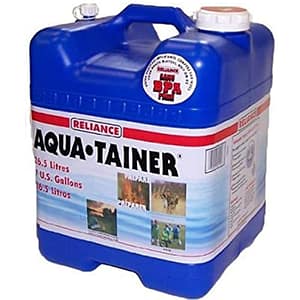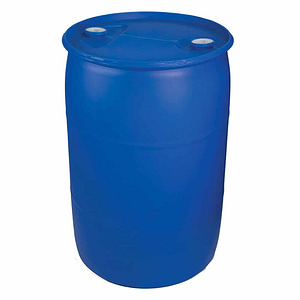There are many emergency supply checklists avaialble, including recommendations from the Federal Emergency Management Agency (PDF), the American Red Cross, and the Centers for Disease Control and Prevention.
These lists can be overwhelming because of the amount of specific things listed! But we can use them as a guide to assemble a basic emergency kit out of stuff you may already own. And there’s no such thing as a single kit that’s exactly right for everyone.
Basic Disaster Supply Kit
FEMA recommends storing items in airtight plastic bags and putting your entire disaster supplies kit in one or two easy-to-carry containers such as plastic bins or a duffel bag. However, some of these items will need to be rotated in and out of your kit, so just remember where they are when you need them. And it might help to have a paper checklist with these supplies.
A basic emergency supply kit could include the following recommended items:
FEMA suggests a minimum of one gallon per person per day for at least three days, for drinking and sanitation. But you should have much more if you can. A 10-14 day supply is excellent.
You should have dedicated containers for water storage and a back up a way to purify water for drinking (re: water purification methods).
Following a disaster there may be power outages that could last for several days. Stock canned foods, dry mixes and other staples that do not require refrigeration, cooking, water or special preparation.
The best emergency-food strategy is to stock your cupboards full of the shelf-stable canned and dry goods you love and routinely eat—think soups, fruits, vegetables, beans, grains, cereals, pastas, nuts, dried fruit, peanut butter, and boxed milk (which, before it’s opened, doesn’t need refrigeration). These items are less likely to expire, since you’re eating and replacing them regularly. Store at least a three-day supply of non-perishable food.
Some suggested emergency food supplies. You may already have many of these on hand.
- Ready-to-eat canned meats, fruits, vegetables and a can opener
- Protein or fruit bars
- Dry cereal or granola
- Peanut butter
- Dried fruit
- Canned juices
- Non-perishable pasteurized milk
- High-energy foods
- Food for infants
- Comfort/stress foods

Note: Food Safety and Sanitation
Without electricity or a cold source food stored in refrigerators and freezers can become unsafe. Bacteria in food grow rapidly at temperatures between 40 and 140 degrees Fahrenheit and if these foods are consumed you can become very sick. Thawed food usually can be eaten if it is still “refrigerator cold.” It can be re-frozen if it still contains ice crystals. Remember “When in doubt, throw it out.”
A good stock-up plan is one that’ll feed a family of four for a month, with grocery-store items you’d eventually eat anyway. And if you keep the freezer door closed, that food should stay safe to eat for 72 hours into a blackout.
Another option is MRE type meals that are packed with calories to give you the energy you need in an emergency situation. They also have a shelf life of up to 5 years.
A good emergency weather radio can tune in to AM/FM and National Oceanic and Atmospheric Administration channels (collectively known as the “weather band”) to keep you informed as well as entertained, even if the power goes out.
This emergency radio also has cool features.
- MULTIPLE POWER SOURCES – Solar Panel, Hand Crank, & the Rechargeable 2000 mAh Battery.
- EMERGENCY FLASHLIGHT – The SOS FLASHLIGHT BEACON flashes Morse code in an emergency scenario.
- NOAA WEATHER SCAN + ALERT – NOAA Weather Scan will automatically scan through 10 available weather (WX) band channels and locks onto the strongest weather channel to alert you of severe weather updates. NOAA Weather Alert will sound an alarm indicating that there is a risk of severe weather in your area.
- CHARGE EXTERNAL DEVICES – Quickly charge your portable devices (cell phones, tablets, etc.) using the USB charging cable (included).
- LARGE LCD DISPLAY
If there is a power outage you might need a light source at some point! Fortunately, almost everyone already has a flashlight or headlamp that they use regularly. No need to pack this away, just know where it is when you need it, and be sure to have extra batteries for it!
Traditional flashlights work, but here are some other options to check out.
We suggest adding a lighter, waterproof matches, or firestarter to this category for good measure. 🔥
Unexpected injuries can happen at any time, and injuries can range from minor cuts and scrapes to more serious ailments. A good first aid kit should be part of any emergency prep kit, and will help in reducing the severity of injuries and preventing infection.
While screaming for help might get a rescuer’s attention, the high-pitch shrill of a whistle is far more likely to cut through emergency sirens, wind, and other loud environmental noises.
Even before COVID-19, masks have been a part of the Emergency kit. While they are now common household items, keeping us safer from transmission of the coronavirus, they can also keep us safe in the event of a wildfire, earthquake, hurricane, or any other situation where dust and debris can make air unsafe to breathe.
Staying clean helps you avoid spreading germs or harboring infection—common problems during extended disasters. Some basic personal-hygiene items you might already have, but want to include in this category:
- moist towelettes
- disinfecting wipes / baby wipes
- hand sanitizer
- toothbrush and toothpaste
- soap
- tampons or menstrual pads
- diapers
A handy tool kit is a necessity in general, but there are common things to have handy in case of emergency.
- Adjustable wrench or pliers for turning off gas or water
- Gas can
- ax
- shovel
- screwdriver
- hammer
- rope
- wire
- razor blades
- duct tape
Staying connected is important in an emergency! So having a plan to keep your Cell phone charged with a backup battery source is imperative.
Other sources of communication can also be considered:
- Land line – a cheap reliable old school connection
- Backup cell phone – get a dumb phone that will last days on a single battery charge!
- Generators can power medical devices or freezers (don’t forget the gasoline and gas can).
- Solar panels can keep your cell phone charged.
- Batteries can keep flashlights running.
In addition to assembling all of your supplies, form an emergency plan with your family. Collect copies of important documents and keep them either in your emergency kit or in another secure place where they remain easy to grab. In an extended disaster, ATMs and credit card machines may go down, stash some cash in your kit just in case.
Remember, every family’s kit will look different, so add things that your family will need! Consider adding the following items if possible:
- Prescription medications
- Non-prescription medications such as pain relievers, anti-diarrhea medication, antacids or laxatives
- Prescription eyeglasses and contact lens solution
- Infant formula, bottles, diapers, wipes and diaper rash cream
- Pet food and extra water for your pet
- Cash or traveler’s checks
- Important family documents such as copies of insurance policies, identification and bank account records saved electronically or in a waterproof, portable container
- Sleeping bag or warm blanket for each person
- Complete change of clothing appropriate for your climate and sturdy shoes
- Fire extinguisher
- Matches in a waterproof container
- Feminine supplies and personal hygiene items
- Mess kits, paper cups, plates, paper towels and plastic utensils
- Paper and pencil
- Books, games, puzzles or other activities for children
Texas Winter Storm Special 🙃
Some of us were without power, water, or heating for extended periods of time in freezing temperatures! Here are some of the things we used, did, and wished we had during the Texas Winter Storm of 2021.
- Five-gallon buckets
- Melt snow for drinking water
- Insulate pipes well and leave cabinet doors open.
- Layered clothing
- Closed rooms not being used
- Huddled in one small room (preferably with a heat source)
- Use duct tape and plastic to cover windows or create warm zones within the house
- Close all blinds and curtains
- Use towels, sheets, and clothing to block drafts
- Burn candles (safely) to help generate heat
- Pile on the blankets
- Pull out useful camping equipment
- Put tent up indoors
- Get a portable generator
- Invest in a wood stove or fireplace

































